Some additional general information about Had Ejectors:
Models built on the I frame have four possible serial # ranges:
1st Model .32 Hand Ejector I frame began in 1896, ended 1903.
2nd Model .32 HE and .22/32 began in 1903.
.38 Regulation Police began in 1917
New Model .22/32 began over again in its own range in 1953
The last three serial # ranges all ended in 1968, although the models continued in new serial ranges that included a letter digits.
Serial # Locations:
Always use optical magnification including a flashlight when looking at or for serial numbers to observe the information accurately.
Pre war fixed sighted guns have serial #s in 6* locations, target** models as many as 9. Triple Locks have 7 including the mid lock cam plate, therefore 10 locations on Target models.
*Post War continued the 6 fixed sight locations thru ~1956, and 9 s/n locations on early Post War Transitional target models with pre war target sights only, thru 1957, but dropped the 3 target sight locations post war on the new Micro-click sighted models, which were no longer specifically fitted to the top strap.
**Target models will have the serial number on:
the front sight,
under rear sight, and
the rear sight blade (although the rear blade can be #'d with the assembly [factory work] # instead of serial #.) If the s/n is more than 4 digits, the front and rear sight blades can have a partial s/n. All three parts must be removed to observe the #s. Non-numbered front and rear sight blades have typically been replaced, in most observations.
We owe the Russians a vote of thanks; having been the 1st to require multi-serial # locations on their S&W #3 contract revolvers.
Target Sight numbering per Mike Priwer:
Photo by Mike Priwer
Photo by Mike Priwer
NOTE: The Factory is known to have pulled a blue gun from the vault for a special order...target sights, nickel finish, etc., and therefore may not have serial #s on added target sights, custom stocks, etc.
Here are the 6 (or 7 on Triple Locks) pre war fixed sight frame serial # locations and locations remaining after WW II thru ~1956 to look for (not including the 3 stamped serial # locations for pre war and early post war Transitional models with pre war target sights):
NOTE: Observing serial #s for accuracy or even existence, especially on penciled stocks, requires magnification, bright light, and an attitude that it is there!
1. Gun butt* - or forestrap* on I frames/single shots with grips that cover the butt
2. Barrel - bottom of barrel or in extractor shroud
3. Yoke - on rear face only visible thru a chamber with a flashlight
4. Extractor star - backside
5. Cylinder - rear face
6. Right stock only** - on back (except most post war target grips because individual fitting not required.)
stamped, scratched or penciled depending on vintage and stock material.
7. Mid-lock cam plate – “Triple Locks” only, in any caliber (up to all 5 digits).
*NOTE: The one TRUE place you can be sure of reading the original serial number for all Hand Ejectors of any vintage with stamped numbers, (which includes any letter prefixed #s after WW II,) is the BUTT of the gun, (or front grip strap on non-round butt .22/32 Kit guns and Targets, .32 & .38 S&W Regulation Police pre Model of 1953 I frames. And the 32 Transitional Targets from 1957). The number on the butt may be drilled thru by the factory for installation of a lanyard swivel but is re-stamped on the grip frame, under the left stock. Factory installed swivels are always 1/10” forward of center.
Generally the Pre war serial # on the butt reads with barrel to the right including I frame serial numbers on the forestrap. After WW II the serial # reads with barrel to the left (except for serial numbers on the forestrap thru 1957).
Pre-War serial #s are centered on the butt, unless there was a swivel. Post War serial numbers are all offset.
** Stamped since 1857, stock #s, almost exclusively on right panel only, changed to penciled #s c. 1900 and back to stamped #s in 1929. Scratched, penciled or stamped on hard rubber and premium stocks; numbering discontinued ~ late 1970s. Pre war penciled S/Ns are in the top half of the stock near the backstrap and read with the stock oriented with the back edge down. Post war numbering switched to lower right half of grip; earliest observed ~1960.
Sometimes a photo like this one is needed to “see” the penciled # as shown below:
Also, finding the penciled serial number was made much easier using The Gimps threshold tool.
http://smith-wessonforum.com/s-w-ha...a-45-model-1917-commercial.html#post138932768
Decreasing Serial # locations: The number of serial #s or if model # is stamped on a particular S&W Hand Ejector has more to do with where it was in the production/assembly stages when change orders were issued, therefore as we've learned to expect with S&W, there are great variances and exceptions galore.
Officially, on May 1, 1957 S&W eliminated the Soft Fitting Operation: So it generally corresponds with model numbers ordered June 12, 1957. It was no longer necessary to routinely stamp the serial number on the barrel, cylinder & yoke arm rear surface and show up unstamped over a transition period. So guns in process or in inventory as of 5/1/57 can still have more than 3 and up to 6 locations, and guns shipped after this time may have some of the former number locations because assembly was done over time and as inventory from the old process was used up.
The 6 serial # locations were down to only 3 left on the majority of models (but not all) from c. late 1957 to 1959 which are:
Butt
Extractor star - backside
Right stock – backside
Model Number Stamping began eventually, sometimes months after being ordered June 12, 1957, but the serial number was not stamped in the ‘yoke cut’, the frame side of the yoke hinge, until late 1959 or early 1960, and then it was only stamped there at first when the revolver model was shipped with target stocks as standard. Soon after, serial #s were stamped on the frame in the yoke cut on all models, except on some smaller guns where it just didn't fit, until later. When stamped in the ‘yoke cut’, the frame assembly # from the yoke cut was moved to the left side of the grip frame.
Yoke cut stamping of the serial # and assembly # have more changes soon after 1957 and get more confusing. When Model Number stamping began not long after being ordered June 12, 1957, the serial number was not yet stamped in the frame ‘yoke cut’ on the frame side of the yoke hinge until late 1959 and early 1960. Then the serial # was only stamped in the frame ‘yoke cut’ when the revolver model was shipped with target stocks as standard. Also soon after, serial #s were stamped on the frame in the 'yoke cut' on all models, except on some smaller guns at first where it just didn't fit well. And when the serial # was stamped on the frame in the ‘yoke cut’, the frame assembly # from the 'yoke cut' was moved to the left side of the grip frame. The 3 assembly # locations, on yoke, left side of grip frame and backside of side plate remain to this day. The yoke cut serial # location on post 1959-60 guns is the reason for many pre 1957 guns to be incorrectly registered by the useless assembly (work) # on the frame in the yoke cut.
Therefore by about the end of 1959, serial # locations went up to 4:
Butt
Frame in yoke cut
Extractor star until ~ 1980 with the new extractor star shape.
Back of right stock, except most target grips because of less individual fitting, until ~ 1979 when no longer hand fitted.
Assembly (factory work) #s: These multi-digit numbers of 3 to 5 digits, are on the yoke at the hinge, in the ‘yoke cut’ on frame opposite the yoke near the hinge, and inside of the sideplate, for the pre war and early post war period. The assembly # in the yoke cut of the frame was relocated to the left side of grip frame after model #s were assigned and the serial # was added in the ‘yoke cut’ where the assembly #, now moved to the left side of the grip frame, used to be. You know they are assembly (factory work) #s because of those 3 locations that always match on guns that are original, and that’s the only usefulness for them after guns leave the factory: still used to this day, long after serial number locations decreased.
“The reason for the triple alpha-numeric serial number system is that S&W ran out of serial numbers that they had been using up to the 1980 and need a serial number series that had enough number possibilities to keep them going for many years. The first guns in the triple alpha four numeric series was the L frame revolvers starting AAA0001 in 1980. The rest of the models were slow phased in from 1980 to approximate 1983. When it came time to assign the new series to the auto-loading handguns they were started at TAA0001. After this the company jumped around in the new series depending if there was a demand for a special number. I actually have three guns serial numbered RGJ0001 - 0003 and they are all different models. ATF objected to the company assigning special numbers and so now they are in a little better order. I hope that this answers your question.” Roy
Once laser engraved serial numbers were introduced, the last two locations continue on the bottom of the butt and in the yoke cut. But there are exceptions, like below the cylinder, left side of frame below the cyl window and may or may not be on the butt.
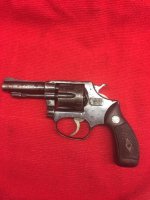 15034242_1024121834379880_1929441205_o.jpg73.8 KB · Views: 160
15034242_1024121834379880_1929441205_o.jpg73.8 KB · Views: 160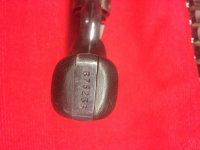 15034084_1024121747713222_1304611851_o.jpg63.5 KB · Views: 104
15034084_1024121747713222_1304611851_o.jpg63.5 KB · Views: 104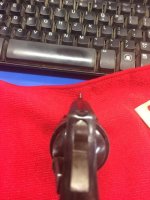 15045435_1024122107713186_1754042815_o.jpg66.4 KB · Views: 97
15045435_1024122107713186_1754042815_o.jpg66.4 KB · Views: 97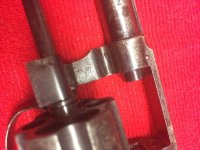 15045448_1024121957713201_2081825655_o.jpg106.9 KB · Views: 95
15045448_1024121957713201_2081825655_o.jpg106.9 KB · Views: 95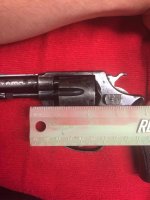 15045449_1024122051046525_228460553_o.jpg60.6 KB · Views: 92
15045449_1024122051046525_228460553_o.jpg60.6 KB · Views: 92






